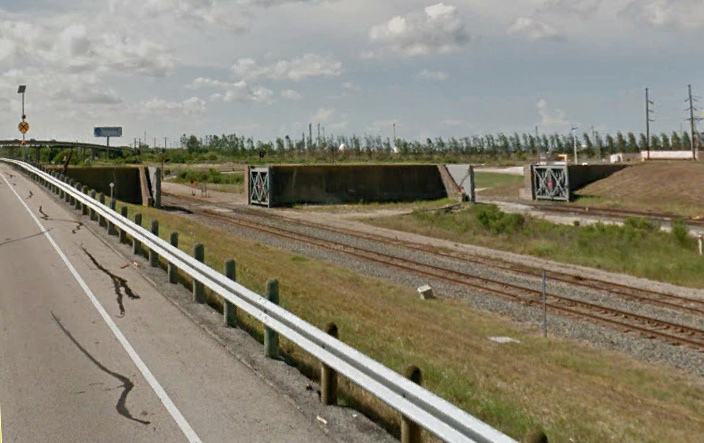Texas Railroad History - Tower 73 - Texas City
A Crossing of the Texas City Terminal, the Galveston,
Harrisburg & San Antonio, and the Galveston, Houston & Henderson railroads
Tower 73 (photo MKT144 in the John W. Barriger III
National Railroad Library)
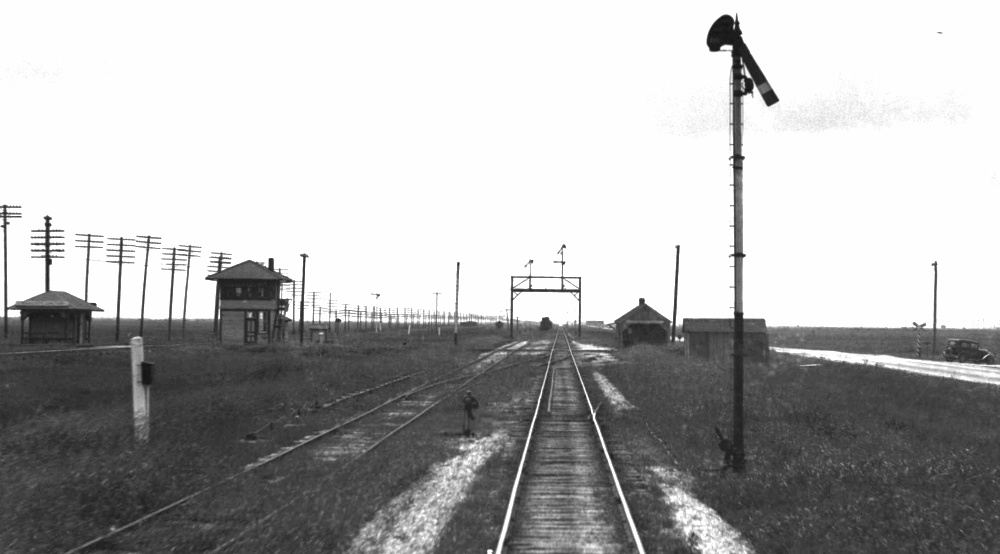
Above: John W Barriger III
took this photo from the rear of his business car in the late 1930's or early
1940's. The photo is MKT144 in a series of photos in the John W Barriger III
National Railroad Library. The next earlier photo in the series is MKT142, and
it shows Tower 96 on Galveston Island. Since the
photos are taken from the rear of the train, MKT142 indicates that the train
was northbound, leaving the island. Though it is not posted in the Library, it
seems likely that if photo MKT143 exists, it was a shot of either
Tower 97 on the Galveston Island causeway, or
Tower 98 at Virginia Point, the next two
significant railroad structures north of Tower 96. The above photo is neither
of these towers (for which several photos exist.) The next tower
north of Tower 98 was Tower 73 at Texas City Junction. There are no known
photos of Tower 73 nor is there extant information that describes the nature of the structure
that was built there. However, there is much that points to the above photo as
an image of Tower 73.
First, as explained
above, it fits with the numbered MKT photo that came before it. It also fits
with the next photo, MKT145, which shows Tower 30 which is the next tower north of Tower 73. The photos after
MKT145 show Houston, hence these photos were taken by Barriger on a trip from
Galveston to Houston on the GH&H Railroad (owned in part by the Katy, hence the
"MKT" photo series designator), a trip that would have required him to pass Tower 73.
Second,
the tower is undoubtedly an
SP tower. It clearly matches the basic design of other SP towers that were built
in the early 1900s. From this angle, it is virtually identical to
Tower 21. It sits along side the GH&SA (SP) tracks as would be expected for an SP
tower. The camera is facing southeast toward Virginia Point and the train is on
the GH&H tracks. It is likely that SP would have built the tower because
among the three railroads at Texas City Junction, SP was clearly the last railroad to become associated with the junction, even if the future SP track
had existed when the TCT was first built. By the time the need for a tower was
established, SP certainly would not have wanted a small port terminal railway to
be responsible for the design and staffing of a modern interlocking tower. The GH&H had existed for more than 40 years before SP became involved with
the junction, so as the second railroad, the tower design (and likely the staffing) would have been SP's responsibility. As there
were no other SP towers on the mainland in the vicinity of Galveston, the MKT
photo sequence and the tower's SP heritage are sufficient to make the case that
this was Tower 73, especially since the existence of two parallel main lines
makes it even more difficult to match to any other known SP tower.
But there's more... Tower 73 had the only right angle crossing track in the vicinity of Galveston.
This track is visible in the image
-- note the crossbuck on the road at right. The tower location astride the SP
tracks and the visible track geometry match the track chart below. The
semaphores on the GH&SA tracks at left center beyond the
tower match the expected locations of the TCT connecting track and sidings shown
on the track chart. And last but not least, the road at right matches the location of the road near Tower 73 today,
west of and parallel to the main tracks. No roadway is visible east of the tower, and that remains the situation at Texas City Junction today.
The number on the tower can't be read, but everything else points to Tower 73.
One of the earliest railroads constructed in Texas was known as the
Galveston, Houston & Henderson (GH&H) Railroad. It was chartered in 1853 and
began service between Galveston and Houston when the first railroad bridge onto
Galveston Island was completed in 1860. After several takeovers, bankruptcies,
corporate restructurings and numerous court cases, ownership of the GH&H became
evenly split between the Missouri - Kansas - Texas (MKT, "Katy") Railroad and
the International & Great Northern (I-GN) Railroad in 1895. Its bridge onto
Galveston Island was destroyed by the great hurricane of 1900 and not rebuilt,
replaced instead by rights to use the Santa Fe bridge (built c.1876) that had
survived the hurricane. Neither bankruptcies, Civil War, nor hurricanes could
defeat the GH&H, which continued to operate as a legal entity until it was
finally merged into the Missouri Pacific (MP) Railroad in 1989, the longest
period of time that a railroad operated under the same name and charter in Texas
history.
Over many years, railroads were organized to try to compete with the GH&H for
the Houston / Galveston market, none of them particularly successful. In 1896,
the latest incarnation of these various combined construction projects, the
Galveston, LaPorte and Houston Railway, completed a bridge across Galveston Bay.
Unfortunately, they were already in bankruptcy by the time the bridge was
finished! The Galveston, Houston & Northern (GH&N) Railway was organized to
acquire the property and soon began operating to Houston, only to have their
bridge destroyed by the hurricane in 1900! Finally, in 1905, the Galveston,
Harrisburg and San Antonio (GH&SA) Railway, which was the first railroad
chartered in Texas (under its original name Buffalo Bayou, Brazos & Colorado),
acquired the GH&N's assets and began providing legitimate competition for the
GH&H. GH&SA was owned by Southern Pacific (SP) and was later merged into
SP's primary operating railroad in Texas, the Texas & New Orleans Railroad.
The bridges over Galveston Bay came ashore on the mainland at
Virginia Point. About five miles north of there,
investors from Duluth, Minnesota, seeing an opportunity to develop a deep water
port on the mainland, created the Texas City Improvement Company to acquire land
and develop the area. In 1893, as the development expanded, they constructed a
4-mile railroad, the Texas City Terminal (TCT) Railway, to connect the port
facilities at Texas City with the GH&H. The TCT's junction was approximately
four miles northwest of Virginia Point, and the junction included a crossing of,
and connection to, the second main track which was owned at the time by the
North Galveston, Houston and Kansas City Railroad. The TCT was
extended two miles further west in 1907 to a connection with the Gulf, Colorado
& Santa Fe (GC&SF) main line that ran west-northwest from Galveston. This TCT
extension required crossing the GH&H and the GH&SA, so an 11-function mechanical
interlocker was installed, commissioned as Tower 73 by the Railroad Commission
of Texas (RCT) on February 18, 1908...or at least that was the first date
reported for Tower 73. In the 1924 RCT Annual Report, a table dated December 31,
1923 revises the Tower 73 date to be February 18, 1907 instead of 1908. This
1907 date persists through the 1931 Annual Report, the last RCT report that
listed all active interlockers.
The fate of the Tower 73 structure in the
Barriger photo is unknown. The GH&H and GH&SA lines are now owned by Union Pacific
(UP), while the TCT is still in operation under that name, jointly owned by UP
and Burlington Northern Santa Fe.
Tower 73 (photo by Stephen Hesse)

Above: At some point, the
manned tower was removed and replaced by a cabin interlocker. Note the control stand with "UP" and "TCT" labels. The
camera is facing east-northeast toward the port of Texas City.
Below: A
Google Street View image of the cabin, dated July, 2013. The view has changed
considerably from the one above due to the construction of a large oil
storage plant owned by Enterprise Crude Pipeline (according to a nearby sign.)
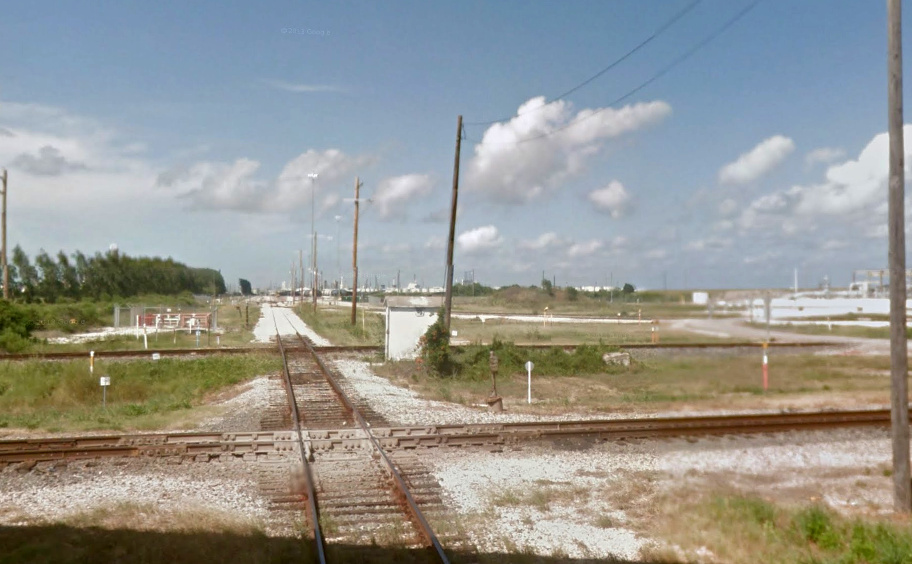
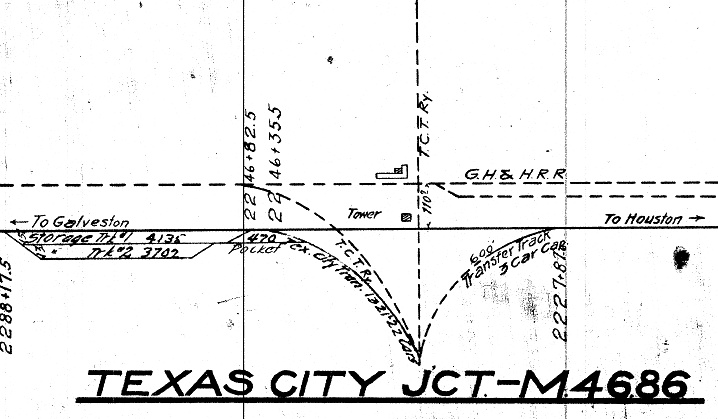
Above: 1926 T&NO Track Chart of
Texas City Junction (courtesy Carl Codney); the location shown for the "Tower" matches the location of
the cabin interlocker in the above photo as well as
the location of the tower in the Barriger photo at the top of this page.
Map, Tower 73 Vicinity

Bird's Eye View of Texas City Junction
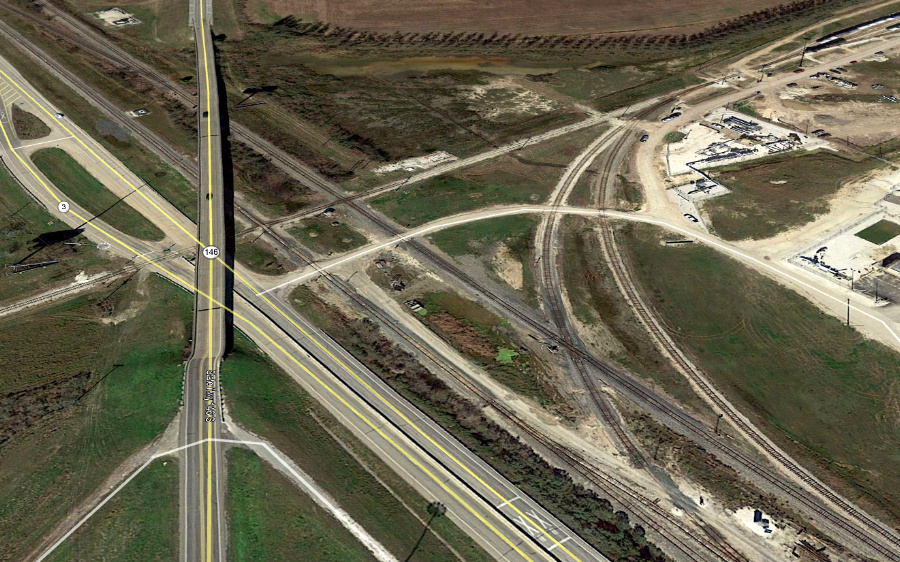
Above: Facing north, the parallel tracks diagonally across the image are the former GH&SA (upper) and GH&H
(lower), heading toward Virginia Point and Galveston off the lower right
corner. The TCT crosses both lines at right angles adjacent to
the Tower 73 cabin interlocker, which is barely visible as a white structure
with a dark shadow above it. A short distance off the left of the image, the TCT
crosses the former right-of-way of the Galveston - Houston Electric Railway.
Below: Just off the lower right corner of the
above image, UP has installed flood gates to attempt to prevent storm surge from
Galveston Bay from reaching the TCT interchange. This adds a whole new
dimension to the concept of a railroad gate!
